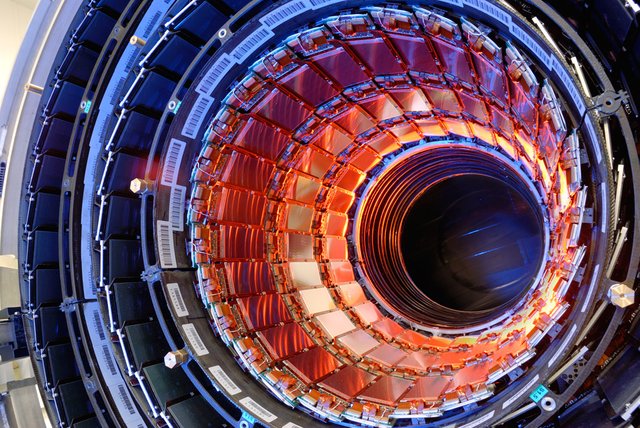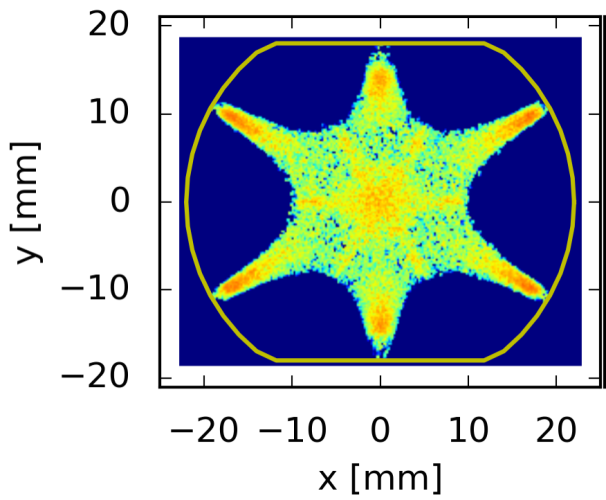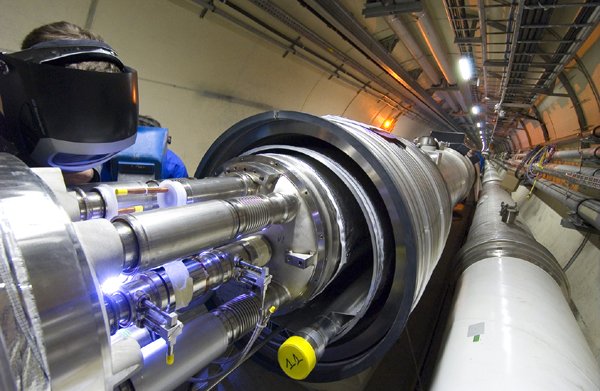Live from CERN - no more clouds in the LHC tunnel
I am feeling like it is a long time I have not written anything about the LHC, the Large Hadron Collider at CERN, which is also known as one of the most powerful machines ever built by humans to explore the phenomenology of the microscopic world.

[image credit: CERN]
The CERN Large Hadron Collider had undergone a technical shutdown during the last winter, and the machine is now being prepared for restarting the physics run.
In other words, protons will soon be collided with the aim of getting an even more precise understanding of the Standard Model of particle physics and of hopefully discovering new phenomena that are expected by many particle physicists.
THE 2016-2017 WINTER LHC SHUTDOWN
During the 2016-2017 winter, the LHC was shut down for technical reasons, as during any winter by the way. During this 2016-2017 shutdown, the machine was warmed up and two sectors of the LHC ring have been opened.
As a consequence of this opening, the inner walls of the ring have been contaminated. The vacuum condition of these sectors where not realized anymore due to the opening. This is the contamination I am referring to.

[image credit: CERN]
This contamination stems from the fact that air is now in these two sectors of the LHC, so that plenty of gas molecules and electrons could enter (together with air).
Of course, when the machine is cooled down again, a very high vacuum is put in place and not a single molecule of any gas or electron is supposed to stay there. However, this is not totally true. Molecules or electrons could be trapped on the walls of the vacuum chamber.
This may not seem to be a problem as long as they stay calmly on the walls. However, once the LHC works, very-energetic protons are organized into two beams that will collide each others. These beams will pass next to the trapped molecules and electrons, and they could free them.
And now the issue: these freed electrons and molecules can be in the way of the beams. We are in fact in the presence of a phenomenon called electron coulds. In very few words, these freed molecules and electrons could destabilize the beams.
PREVENTING BEAM DESTABILIZATION BY CLEANING
In order to avoid such a phenomenon, the inner walls of the vacuum chamber must be cleaned. This is done in a very specific way, that permits to inhibit any future formation of clouds.
By the way, such a cloud as the shape of a star, as illustrated on the figure below, which represented a typical electron distribution on one of the LHC magnets.

[image credit: CERN]
Before entering into the details of the cleaning process, it is good to remind what a beam circulating into the LHC machine is made off. It consists of bunches of protons, and each bunch is separated from each other.
The way to measure this spacing is in general expressed in nanoseconds, and the LHC is expected to handle, under the 2017 running conditions, beams made of 2556 bunches spaced by 25 nanoseconds each.
That consists of a lot of protons and we must hence be sure to keep the beams into control (and to avoid electron clouds).
In order to remove the electrons trapped in the vacuum chamber, one starts by injecting beams made of a small number of long bunches. This small number is here 288, for those interested in numbers. Which is indeed small as when compared to the 2556 number mentioned before.
Those conditions are actually quite far from the normal working conditions, but it is good to move on little by little (or at least step by step) to avoid troubles.
This special beam has the role of bombarding the inner walls of the tube in order to provoke as many electron clouds as possible. The walls are consequently less and less likely to induce, in the future, the formation of new clouds. Which is in particular important when the very-energetic and dense beams useful for physics will circulate in the tunnel.
As a result, the sectors that have been opened have started to heat a lot. This was expected, as the electrons trapped on the wall are being scrubbed and hence lead to an increase of the heat load.
After a few days, the head load decreased, as there are less and less electrons to be scrubbed. As expected, And consequently, the beam quality improved.
It is now time to start the more serious work! The cleaning is indeed not done yet.
FINAL CLEANING WITH MORE POWERFUL BEAMS
However, as above mentioned, we are still far from the usual LHC working conditions.
A couple of weeks ago, a beam containing a huge number of 2820 bunches was injected into the machine. The resulting heat load was stil non negligible, but it was nicely taken care of by the fast-reacting cryogenic system of the machine.

[image credit: CERN]
At that time, there were however still a dense presence of electron clouds that were causing a slight degradation of the beam. The heat load nevertheless move on in decreasing (less and less clouds), and reaches the value that it had at the end of 2016.
Almost ready to go for physics!
After a few extra tests and a couple of days of running with test beams, the LHC is today free from electron clouds. It is hence ready to receive more and more powerful beams that will be used for physics.
This will happen very very soon.
SUMMARY AND REFERENCES
This post was motivated by my regular reading of the CERN bulletin thar I read regularly. I have briefly summarized some of tests that have been performed around the CERN Large Hadron Collider.
The machine is today almost ready for its 2017 run for physics, and the cleaning of the electron clouds (that was the topic of this article) potentially dangerous for the beams has been finalized.
For more information, I recommend browsing the CERN LHC website. Moreover, extra details on the news I discussed can be found on these two pages:
Thats cool!, i thought you worked on cern!... You know whats the next experiment looking for?
I worked there from 2012 to 2014 and am still visiting CERN regularly (and I am still collaborating with CERN people for some time). There are many experiments being run at CERN. If you are wondering about the possible next collider, there is a project but nothing is sure concerning the fact it could ever happen (the so-called FCC project I have mentioned in some other posts).
I can just imagine how hard it mustt be to clean the walls without contaminating further. Quite fascinating!
Calculations can be made so that the above procedure works :)
Are they mining for Anti-Matter?
Only to sell it instantly for Anti-Anti-Matter.
That sounds very mattery :D
Antimatter can be produced in LHC collisions, but it cannot be stored. Antimatter is unstable and only leaves tracks in the detectors (so that we can understand what has been produced).
I have been read an article about it, nice info, its a big project they have made
This project is not only big, but also discussed for more than 30 years! We needed a lot of effort to make it happen.
I think so dude
This is a great article, my friend.
I am very interested in what is going on at CERN and this article came along at just the right time.
Not sure where I read or saw something about a HUGE collider they started building in the US, Texas I think. The ring was something like 100 miles. It was abandoned.
Ever hear of it?
upvoted and resteemed!
You may be talking about the SSC project that was indeed abandoned long ago. The ring was actually expected to be smaller (50 miles roughly). The project was abandoned because the US government of that time preferred to fund military stuff, if I am not wrong (this was before my time). The wikipedia page is a good start to get more information about it.
So I wasn't dreaming then.
Thanks for the info!
My pleasure! :)
I discovered steemSTEM because of this article! I was getting bummed by all the pseudo-scientific plagiaristic articles here (that get lots of votes regardless), so it's spiriting to find there's a project like this.
If only there was something similar for other areas of academia, like philosophy which is my field of interest.
Concerning philosophy, not to my knowledge. For the STEM part, we are really doing our best, but we may feel like being out-numbered :)
Can it be that you have a lot of spam commenters??
Looks like I am super popular in spam, indeed! What can I do?... :)
Flag them!
Its a bit of a waste of voting power, but if they all get flagged enough they get invisible and unusable.
I flagged two very blatant examples - one even copy-pasted the same typo comment over and over lol
Yep! Good idea (I am not really flagging in general but too obvious spam is hurting my eyes).
Really cool as always. Have you written in detail on how the various sensors actually work? I went back and couldn't find anything in your posts, but to me it's one of the more confounding parts of the whole enterprise - building the accelerator itself is one thing - but building the building sized devices that sense the results of the collisions - and how those work - is a total mystery to me.
I have never written anything about the electronics of the machine, but I may consider it in the future as you asked about it. ~I could detail how a particle physics detector works in general. Maybe one day (I need to read a little bit about it as this is a bit far from my field) :)
So exciting. Hope you'll be posting some more :)
I will, as I am for more than 9 months :)
They already created a dark hole in CERN. Pretty scary. However, great article, you got my upvote save. If you are interested in science and investing in it, feel free to check out my articles too.
Let's get wealthy together
Best
Alex
I am not aware of CERN having created any dark hole (I don't even know what this thing is) at all. Do you have some references or more information about that?
Sure, just 2 examples
http://www.huffingtonpost.com/george-elerick/cern-scientist-reassures-_b_8411468.html
http://www.express.co.uk/news/weird/694392/Will-Large-Hadron-Collider-destroy-Earth-CERN-admits-experiments-could-create-black-holes
Ahaha. A black hole is not a dark hole. A dark hole is actually meaningless. However, one must be careful with such readings.
I hope this clarifies :)
Thanks it does. I will dig deeper into this and maybe will do an article about it
Just let me know if this is the case. I will be more than happy to comment :)